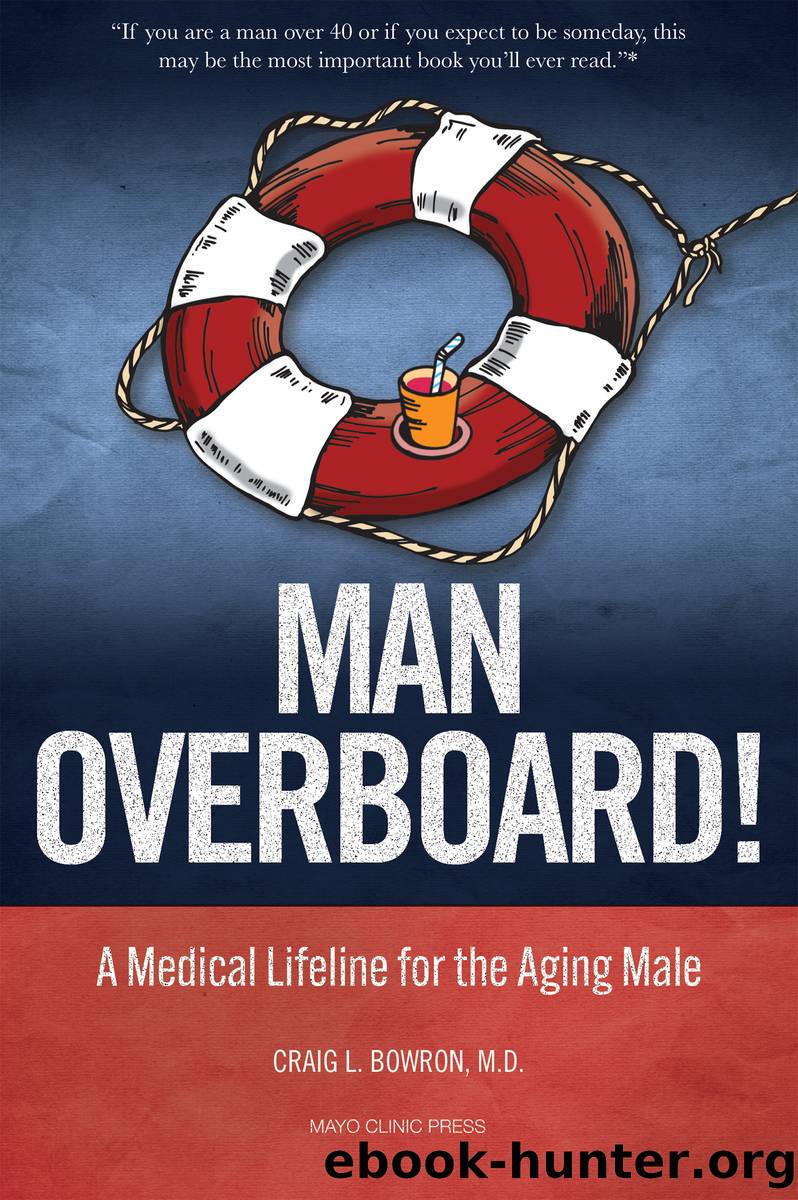Man Overboard! by Craig Bowron M.D

Author:Craig Bowron, M.D. [Bowron, M.D., Craig]
Language: eng
Format: epub
Publisher: Mayo Clinic Press
Published: 2022-07-28T00:00:00+00:00
Isnât Exercise a Young Manâs Sport? Isnât It Hard on Joints?
When I was growing up, gyms were only found in schools and bigger churches, not in every strip mall or peopleâs homes. Exercise training was what one did to participate in a sport, and sports (save menâs softball, oddly enough) were for kids. The line on strenuous exercise and athletic training (anything more than a brisk walk) for adult men and women was that it was either unnecessary (âIâm not playing a sport, so why should I be training for one,â âI already work for a livingâ) or that, with advancing age, they were simply too frail for it. Theyâd just end up hurting themselves.
This relationship between perceived frailty and risk of injury is a kind of self-fulfilling prophecy. To avoid injury or a heart attack, you might talk yourself into avoiding anything but low-intensity exercise, which then leaves you more prone to the very things you were looking to avoid: injury and heart disease. The truth is that when anyone of any age is out of shape and tries to exert themselves, the risk of injury is higher. Itâs certainly true that older folks take longer to recover from injuryâmuscle fibers torn with strengthening exercises can heal in two weeks for the youthful, and a month for the not-so-youthful.
One frequently voiced concern is that more aggressive exercise could end up wearing out oneâs joints and lead to arthritis. That idea holds up to some commonsense scrutiny: the screen door hinge has only so many turns in it before the repetitive movements abrade the metal and the hinge loosens up, which only accelerates the wear.
Like the door, our joints are mechanical in nature, but unlike the door, our joints are alive. The living âconnective tissueâ of our bones, ligaments, tendons, and cartilage are in a perpetual state of remodeling, and they respond to stresses (rather miraculously) by increasing that remodeling, bulking up in areas where extra heft is needed.
So regular exerciseâeven intense exerciseâis good for our joints. The increased risk for osteoarthritis that comes with participating in sports is thought to be due to either a single-impact kind of disaster (the fall onto the shoulder, the weirdly twisted knee), or to a series of smaller-impact disasters (so-called âdings,â as in âI dinged up my shoulder playing sand volleyballâ), and not due to regular use.
There is one way in which the door-hinge analogy does hold up: our joints are indeed mechanical, and they work the best when alignments are optimal. Injury comes most easily at the extremes of position, when the joint is misaligned and not in a good position to handle a load. This is why body mechanics and ergonomics are so important, particularly for a patient with low-back pain who needs to lift a weight. Muscle strength is also critical, because muscles are important in maintaining proper joint mechanics. For example, quadriceps strength is critical to knee stability. Flexibility helps to maintain posture and joint mechanics too.
Download
This site does not store any files on its server. We only index and link to content provided by other sites. Please contact the content providers to delete copyright contents if any and email us, we'll remove relevant links or contents immediately.
| Bone Cancer | Brain Cancer |
| Breast Cancer | Colorectal |
| Leukemia | Lung Cancer |
| Lymphatic | Prostate Disease |
| Skin Cancer |
Men In Love by Nancy Friday(5197)
Everything Happens for a Reason by Kate Bowler(4704)
The Immortal Life of Henrietta Lacks by Rebecca Skloot(4552)
Why We Sleep by Matthew Walker(4395)
The Sports Rules Book by Human Kinetics(4348)
Not a Diet Book by James Smith(3380)
The Emperor of All Maladies: A Biography of Cancer by Siddhartha Mukherjee(3114)
Sapiens and Homo Deus by Yuval Noah Harari(3033)
Day by Elie Wiesel(2752)
Angels in America by Tony Kushner(2624)
A Burst of Light by Audre Lorde(2570)
Endless Forms Most Beautiful by Sean B. Carroll(2446)
Hashimoto's Protocol by Izabella Wentz PharmD(2352)
Dirty Genes by Ben Lynch(2295)
Reservoir 13 by Jon McGregor(2267)
Wonder by R J Palacio(2184)
And the Band Played On by Randy Shilts(2169)
The Immune System Recovery Plan by Susan Blum(2041)
Stretching to Stay Young by Jessica Matthews(2013)
